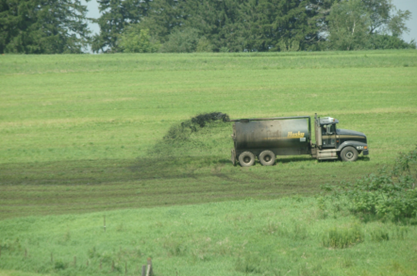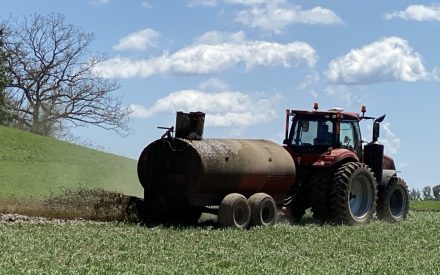Manure is a nutrient, not a waste
A common misconception about livestock manure is that it is simply a waste product of the farm. However, manure is rich in many nutrients and is a valuable resource when applied back onto fields that can benefit from manure application. Research has demonstrated positive impacts to soil quality/health, crop production, and overall farm management when manure is managed effectively. There are, however, water quality and natural resource concerns related to the improper management of manure. In Wisconsin, dairy farms are prominent, resulting in large amounts of manure production annually; most of which is applied back onto the fields for future crop production. Accounting for the nutrient content of manure and crediting that nutrient content towards the following year’s crop nutrient demand is imperative, both for farm profitability and environmental protection.
Manure nutrient content, availability, and value
Nutrient content of manure is dependent on several factors, including animal species, incorporation method and timing (for Nitrogen), and form (i.e. solid vs liquid). Manure nutrient book-values are commonly used to give growers and nutrient management planners a “ballpark” idea as to what their manure nutrient content is, however, the best practice is to collect samples from each manure source on the farm and have them tested at an approved laboratory. Recommended manure sampling methods can be found on the UW Soil and Forage Analysis Laboratory website, while a list of approved manure analysis laboratories in WI can be found on the Department of Agriculture, Trade and Consumer Protection website. Additionally, the total amount of nutrients in manure are generally not 100% available to crops; rather, a percentage of the total becomes available over a 1 to 3 year time period. Factors such as animal species, form, and application / incorporation practice influence nutrient availability of manure to crops. For more information related to typical nutrient content and nutrient availability of manure, please reference Chapter 9 in UW-Extension Publication A2809 (Nutrient application guidelines for field, vegetable, and fruit crops in Wisconsin).
The value of livestock manure can be determined by comparing the nutrient value to your fertilizer prices. Using data from Table 1 (below) for liquid dairy manure, a field receiving 10,000 gal/ac would contribute ~$143.60/acre in total nutrient value, for example. Consider factors that can influence this monetary evaluation (i.e. change in fertilizer-nutrient prices) of manure as a resource, and expect fluctuations over time.
Table 1. Typical total nutrient content (i.e., book-values) of Dairy-Liquid and Dairy-Solid manures, estimated monetary value of each nutrient (values in parentheses), and total estimated nutrient values over various manure application rates.
| Nutrient †,‡ | Dairy-Liquid (<4.0% DM) | Dairy-Solid (>20.0% DM) |
|---|---|---|
| N | 7 ($4.34) | 3.2 ($1.98) |
| P2O5 | 4 ($2.76) | 4 ($2.76) |
| K20 | 14 ($6.16) | 7 ($3.08) |
| S | 1.1 ($0.65) | 1.2 ($0.71) |
| Total Nutrient Value | $14.36 | $8.53 |
| Application Rate | Liquid Nutrient Value/Acre | Solid Nutrient Value/Acre |
| 5,000 gal/ac OR 5 T/A | $71.80 | $42.65 |
| 10,000 gal/ac OR 10 T/A | $143.60 | $85.30 |
| 15,000 gal/ac OR 15 T/A | $215.40 | $127.95 |
† Units for total nutrient content are: Pounds per 1,000 gallons (for Dairy-Liquid) or Pounds per ton (for Dairy-Solid). These values are from Table 9.2 in UW-Extension Publication A2809, 2012. Nitrogen content is based on estimated 1st year availability (assuming injection for liquid and less than 1 hour to incorporation for solid) while that for P, K, and S are total nutrient values.
‡ Nutrient prices were based on the UW-Extension Fertilizer Price Survey from Spring 2023 and are: $0.62/lb N; $0.69/lb P2O5, $0.44/lb K2O; and $0.59/lb S.
Water quality impacts
One reason to carefully manage manure is for the financial value, but a second reason is the potential impact on water quality. Nitrates entering drinking water pose a human health risk, such as raised heart rate, nausea, headaches, and methemoglobinemia (blue baby syndrome). In Wisconsin, when excess phosphorus enters into streams, rivers, or lakes, it can cause eutrophication. This triggers plant and algae growth, negatively impacting the environment for fish and other aquatic species. A few examples where manure can contribute to water quality issues are over application of manure, manure spreading before a rainfall, and manure spreading on frozen soil.
Spreading recommendations
Having multiple options to spread manure throughout the growing season is extremely valuable for the farmer and the environment. Options that allow spreading during better weather conditions, such as late spring and summer, are also when fields have more erosion-reducing vegetation coverage (intercepting raindrops) and a growing crop to immediately use the nutrients. Spreading manure on growing plants means that plants can immediately take up nutrients, rather than leaving them vulnerable to moving off the field. During summer months, weather conditions tend to be drier and have less chance of large runoff events, further reducing the risk.

Incorporating manure into a small grains or alternative forage rotation would also be a great option in summer months. New technologies and equipment allow spreading on standing crops without reducing yields. The Ohio State University has investigated different timings and ways to spread manure on standing corn. In a 4-year study, they found that using a dragline to spread manure did not impact corn yields if used before the V5 stage.
Spreading manure in the fall after harvest leaves manure’s nutrients untouched by plants until the following spring and susceptible to losses via erosion or runoff. If spreading manure in the fall, choose fields that have a growing cover crop or have large amounts of crop residue on the surface. Wait until microbial activity slows down when soil temperatures cool, but before soil freezes to help reduce nitrogen losses (soil temperature below 50 degrees F).

If possible, it’s best to not spread in the wintertime, once soil is frozen. Infiltration slows down or stops when the soil is frozen, which means that any rain that falls on frozen soil is more likely to run off the field. If manure must be spread, choose a location with low slope, well drained, far from surface water, and that has vegetative cover throughout the winter.
The UW Soil Nutrient Application Planning Software (SnapPlus) has tools built within it that provide recommendations on the best management practices related to manure. Ideally, manure and fertilizer should be applied as close to the crop’s nutrient uptake as possible, with application methods fine tuned to reduce nutrient losses by erosion or to the atmosphere.

 ▶Watch: Manure and water quality: Why looking at the calendar matters
▶Watch: Manure and water quality: Why looking at the calendar matters Managing manure to reduce negative water quality impacts: Composting on Wisconsin farms
Managing manure to reduce negative water quality impacts: Composting on Wisconsin farms The best times to spread manure and why
The best times to spread manure and why Avoiding manure overapplication, one way to mitigate the risk of nutrient runoff
Avoiding manure overapplication, one way to mitigate the risk of nutrient runoff


